Lubricating Electric Motors
Lubricating Electric Motors
Electric motors contain bearings that require lubrication. Most electric motors use grease. Ideally the grease should have:
- dropping point above 204°C (400°F),
- low bleed characteristics,
- excellent resistance to high-temperature oxidation, and
- good anti-wear properties.
Typical thickeners include lithium, calcium, bentonite, and polyurea. One of the biggest issues is that these thickeners are not compatible with each other which will cause problems and bearing failure if greases are mixed randomly.
If the bearing size is known or can be determined, the amount of grease needed can be calculated by G=0.114 X D X B, where G is the amount of grease in ounces, D is the outside diameter of the bearing in inches and B is the bearing width in inches. So, a bearing that is 3 inches in diameter and ½ inch wide would require 0.17ounces or 4.8 grams of grease. A postal scale or other small scale can be used to determine the number of pumps from a grease gun will give you the desired amount.
Procedure:
- Remove the drain plugs or relief valve underneath the bearings on both ends of the motor.
- Clean the area around the grease fitting (Zerk)
- Slowly add grease through the grease fitting until you see grease coming out of the drain. If purging out old grease continue slowly until new grease appears.
- Run the motor until it comes up to normal operating temperature.
- Clean excess grease from the drain area and replace the plug.
Care must be taken not to over pressurize the grease going in as it may rupture seals and fill the winding cavity. A typical grease gun can generate over 15,000 psi (>1034) of pressure.
Possible failure causes:
- Grease incompatibility, if a different grease is used the thickeners may not be compatible. They could become liquid and run out of the bearing
- Motor casing full of grease, excessive grease will act an insulator can cause the motor to run hot and damage the windings.
- Lubricant starvation due to too long of lubrication intervals or grease incompatibility.
- Incorrect lubricant, the grease has a base oil of over 500 cSt at 40°C, high extreme pressure characteristics, or is not compatible with the previous grease.
As with most equipment, proper lubrication and maintenance will help extend the useful life and performance.
We recommend SWEPCO 101H (EP-2) or SWEPCO 121H (EP-2) for electric motors, depending on previous used grease (thickeners) regarding compatibility.
Source: SWEPCO®


